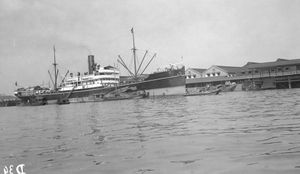Shantung II
Sister ship of the Sinkiang I
Contents
History
Here again there is confusion as to the correct name of the ship.
The vessel is listed as "Shan Tung" under the Lloyds registers from 1887 to 1932, and the Mercantile Navy Lists of 1917 to 1933. The Taikoo Dockyard records refer to her as "SHANTUNG". The ship's name painted on the ship's side is "SHANTUNG" and company correspondence usually refers to the vessel as "Shantung"
1915. Delivered to China Navigation Co., but under the control of the Shipping Controller until the end of hostilities, when it was returned to CNCo.
Aug 2nd.1922. Blown ashore during a typhoon at Swatow. Dec.1922. Refloated.
Under direction of MOWT during WW2.
1945. Returned to Far East for normal operations.
Dec 1947. Laid up in Hong Kong pending Sale.
May 27th. 1948. Sailed for Shanghai for delivery to shipbreakers. Broken up June 1948.
Service
Built for the China coast trade.
Events / Stories
Captain Leslie Joseph Money served with CNCo between 1937 and 1947. What follows is his account of how Shantung narrowly escaped an enemy torpedo off Colombo, during the Second World War.
In 1942, the 2,549-ton Taikoo-built coaster Shantung, was requisitioned as a Naval Armament Carrier. Leslie Money joined the vessel at Bombay, in March of that year; and in May, Shantung sailed for Colombo carrying Naval ammunition. At this time, Shantung was equipped with a single 12-pounder HA/LA gun, vintage 1912, for which she carried only eight HE shells. This limited arsenal was supplemented by six Oerlikon guns, erected in pairs along the length of the ship's upper deck, and a Lewis gun mounted on her wheelhouse. Shantung carried two “DEMS” ratings, but apart from this, her gun crew was made up from the ship’s own CNCo complement.
After arrival in Colombo, we took on board further armament stores, including two tanks of Fulminite of Mercury detonators (not known for their stability). These were stored in the after peak store, located below the poop, and immediately below the 12-pounder gun platform.
Our departure from Colombo was delayed due to reports of an enemy submarine operating off the South of Ceylon (Sri Lanka), but eventually we sailed in company with three other Naval auxiliaries, under the escort of the sloop HMS Grimsby - an old friend from the China station.
Our initial destination was “Port T” - a supposedly secret destination in the Maldives. It was actually Addu Atoll. Thence we were to proceed to a rendezvous with the Fleet off the North of Madagascar, and finally we were to sail for the Eastern Mediterranean, to replace a ship on similar duty, which had been blown up during an air raid on Haifa. (This comforting information came to us later).
We also learned later that Grimsby had instructions to ensure - insofar as she could - that Shantung had a safe passage. We had on board almost the entire reserve stock of certain Naval ammunition in the area, due to losses by sinkings.
After clearing the swept channel outside Colombo just after dark, the four ships formed up in line abreast, Shantung being the port-hand vessel, with Grimsby ahead on anti-submarine sweeps.
Shantung was to find herself always allocated the outermost and last position in subsequent convoys we joined; this gave us an unpleasant feeling of vulnerability and, as I remember, many sleepless nights.
About 22.30hrs on the night of our departure, we heard the unmistakeable sound of the Escort making the “scatter convoy” signal on her siren, indicating a submarine in the immediate vicinity. Old CNCo personnel will appreciate that Shantung had much greater ability to manoeuvre quickly than our consorts, they being of greater tonnage. We also had the edge on them in speed, and so rapidly became separated from them.
It will be appreciated that it is most unnerving to see a torpedo coming straight at one, especially when it is heading directly for the Fulmanite of Mercury detonators and one is on the gun platform immediately above. Likewise the relief of seeing its wake pass off on the other side. The track of the torpedo was particularly clear, due to considerable phosphorescence in the water. This also enabled us to believe we spotted the wake of a periscope in at least six different locations.
At the subsequent post mortem on board Grimsby, after arrival at “Port T”, we speculated as to why the torpedo had passed beneath us and why there was no further attack. As to the first point, either the submarine commander misjudged our draft, or at the precise moment the torpedo should have hit us, we were lifting to the slight swell - accentuated by our applying maximum helm whilst taking avoiding action.
On the second matter, we could only assume the submarine had fired her last torpedo - there had been considerable sinkings in the area recently - and had avoided surfacing and engaging in a gunfight. Not that our own eight rounds would have been very much use. In any case, with the exception of the DEMS ratings, our gun crew was totally untrained. I was personally aware of this, as I was in charge of the ship’s armament. The incident was a great spur to us becoming proficient in our gun drill.




